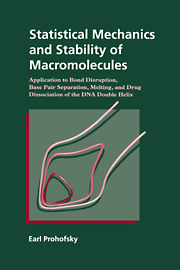 Statistical Mechanics and Stability of Macromolecules
Statistical Mechanics and Stability of Macromolecules Published online by Cambridge University Press: 16 September 2009
Dynamics of macromolecules
Biological macromolecules carry out functions that require them to have very complex physical and chemical dynamics. Theoretical analysis of that dynamics has proven very difficult because the macromolecules are large systems whose dynamics is very nonlinear. The large size arises because the systems have many atoms which cannot be simply related by symmetry operations and the dynamics has to be analyzed down to motions on the atomic level to fully appreciate what is going on. This microscopic approach is important because macromolecules often function by changing their conformation on the atomic level. The nonlinearity results because many bonds are weak relative to physiological temperatures, in many biological processes bonds are broken and bonding rearranged. In this book we detail a method for studying macromolecular dynamics that is particularly well suited to large systems that are also highly nonlinear. With an additional operator included the method is particularly useful in studying the dissociation of chemical bonds in large nonlinear systems. We know of no other approach that can efficiently study the melting or bond disruption problem in such large systems on a microscopic scale. To date the majority of the applications of this method, and those presented in this book, are to problems of base pair separation in the DNA double helix. The advantages and disadvantages of the method and how it may be extended to other systems can, however, be seen in these applications.
To save this book to your Kindle, first ensure [email protected] is added to your Approved Personal Document E-mail List under your Personal Document Settings on the Manage Your Content and Devices page of your Amazon account. Then enter the ‘name’ part of your Kindle email address below. Find out more about saving to your Kindle.
Note you can select to save to either the @free.kindle.com or @kindle.com variations. ‘@free.kindle.com’ emails are free but can only be saved to your device when it is connected to wi-fi. ‘@kindle.com’ emails can be delivered even when you are not connected to wi-fi, but note that service fees apply.
Find out more about the Kindle Personal Document Service.
To save content items to your account, please confirm that you agree to abide by our usage policies. If this is the first time you use this feature, you will be asked to authorise Cambridge Core to connect with your account. Find out more about saving content to Dropbox.
To save content items to your account, please confirm that you agree to abide by our usage policies. If this is the first time you use this feature, you will be asked to authorise Cambridge Core to connect with your account. Find out more about saving content to Google Drive.